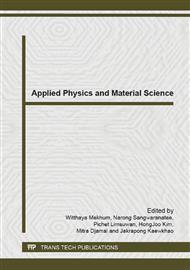p.280
p.285
p.289
p.293
p.297
p.302
p.307
p.311
p.315
London Penetration Depth of Fe-Based Superconductors
Abstract:
Superconductivity is a phenomenon of exactly zero electrical resistance and expulsion of magnetic fields occurring in certain materials when cooled below a characteristic critical temperature. Fe-based superconductors are superconductors whose containing iron compounds and having a very high critical magnetic field. London penetration depth can assist in the study of the behavior of the critical magnetic field. The London penetration depth is the distance to which a magnetic field penetrates into a superconductor and becomes equal to 0.367879 times that of the magnetic field at the surface of the superconductor. In this paper, the London penetration depth of Fe-based superconductors is studied by Ginzburg-Landau scenery. Free energy of Fe-based superconductors is assumed by modified the free energy of two-band magnetic superconductors model and theof Fe-based superconductors is derived analytically. Finally, the temperature dependence of is investigated and applied to Single-Crystal superconductors.
Info:
Periodical:
Pages:
297-301
Citation:
Online since:
June 2014
Authors:
Price:
Сopyright:
© 2014 Trans Tech Publications Ltd. All Rights Reserved
Share:
Citation:



